What are the major provinces, regions, cities, towns and communities in Nicaragua and what is each one like?
Estefanía Calvet
Nicaragua has several cities that are very important for various historical reasons. We all know that the capital of Nicaragua is Managua, which was largely destroyed by the earthquake in 1972 but was rebuilt. Now Managua is divided and there is old Managua, where you can see old buildings like the Cathedral, the Republic Palace and others.
León was once the capital of Nicaragua and the first city to win the war against the...
Nicaragua has several cities that are very important for various historical reasons. We all know that the capital of Nicaragua is Managua, which was largely destroyed by the earthquake in 1972 but was rebuilt. Now Managua is divided and there is old Managua, where you can see old buildings like the Cathedral, the Republic Palace and others.
León was once the capital of Nicaragua and the first city to win the war against the Somozas. León is still a colonial city where the University started and where the Cathedral of La Asunción de María (a Humanity Patrimony) it located.
Granada was also once the capital of Nicaragua. Its also a colonial city, next to the big lake of Xolotlán, where you'll find sharks, and the Isletas (which are volcanic island formations).
We also have the ghost towns or white towns, very small and full of traditions and mystery. A lot of stories come from those towns.
Masaya, "Tierra del Folklor" ("Land of Folklore")
Posted May 9, 2014
John-Marc Gallagher - GPS Real Estate
In Managua, Nicaragua, you will see couture, and you will see expensive sports cars. However, the country of Nicaragua is such an agrarian society that once you step minutes outside of Managua, it’s as if you are stepping from one century to another. The same is true of the other more urban areas of the country. And the further away from Managua or these other areas you go, the centuries continue to roll backwards.
In Managua, Nicaragua, you will see couture, and you will see expensive sports cars. However, the country of Nicaragua is such an agrarian society that once you step minutes outside of Managua, it’s as if you are stepping from one century to another. The same is true of the other more urban areas of the country. And the further away from Managua or these other areas you go, the centuries continue to roll backwards.
Posted August 8, 2014
Maria Acosta
Granada
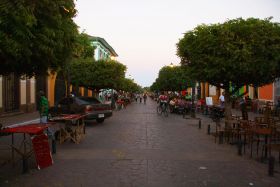 Granada is a colonial city in Nicaragua on Lake Nicaragua. It has wonderful, modern houses that have been amazingly remodeled by their new owners. Although they have been remodeled, you can still see some facades that are consistent with the architecture of the whole city. Granada is very close to Managua and is just 30 minutes away from the Hospital Metropolitano Vivian Pellas. Also, there’s a school for children in Granada that was founded...
Granada is a colonial city in Nicaragua on Lake Nicaragua. It has wonderful, modern houses that have been amazingly remodeled by their new owners. Although they have been remodeled, you can still see some facades that are consistent with the architecture of the whole city. Granada is very close to Managua and is just 30 minutes away from the Hospital Metropolitano Vivian Pellas. Also, there’s a school for children in Granada that was founded... Granada
 Granada is a colonial city in Nicaragua on Lake Nicaragua. It has wonderful, modern houses that have been amazingly remodeled by their new owners. Although they have been remodeled, you can still see some facades that are consistent with the architecture of the whole city. Granada is very close to Managua and is just 30 minutes away from the Hospital Metropolitano Vivian Pellas. Also, there’s a school for children in Granada that was founded by an American teacher, so you can find a bunch of young people and young families there.
Granada is a colonial city in Nicaragua on Lake Nicaragua. It has wonderful, modern houses that have been amazingly remodeled by their new owners. Although they have been remodeled, you can still see some facades that are consistent with the architecture of the whole city. Granada is very close to Managua and is just 30 minutes away from the Hospital Metropolitano Vivian Pellas. Also, there’s a school for children in Granada that was founded by an American teacher, so you can find a bunch of young people and young families there. I find the city of Granada to be more international compared to Managua. Nature-wise, Granada is a beautiful town. You can go up the extinct Mombacho volcano, which is just 20 minutes away. There are also a lot of nature trails and animals that you can observe. Another place you can also visit are the islands of Granada (Las Isletas), which are over 300 little islands located in Lake Nicaragua. Interestingly, there are few small houses on some of those islands, too.
Recently, the government renovated the lakefront area. Boating and other types of water sports are available on the lake.
Managua
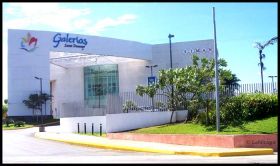 Managua is a big, hectic city. There are movie theaters, huge shopping malls, a lot of restaurants and bars, and other places to go at night, especially for younger people. A lot of people immigrated here from other nearby cities to look for a job. The population of Managua is more than 2 million and it’s mostly Nicaraguans. Unlike Granada, there are not a lot of expats in the city area of Managua.
Managua is a big, hectic city. There are movie theaters, huge shopping malls, a lot of restaurants and bars, and other places to go at night, especially for younger people. A lot of people immigrated here from other nearby cities to look for a job. The population of Managua is more than 2 million and it’s mostly Nicaraguans. Unlike Granada, there are not a lot of expats in the city area of Managua. I live in an area called Carretera Masaya, which is on the same road that leads you to Granada. From my house, I can see the lake, so we have a bit of elevation. We are a bit far from the city center too, so there’s not too much noise in our neighborhood.
A long time ago, an earthquake destroyed the downtown area where the government buildings and big banks were located. So for many years, Managua didn’t have a city center, while it grew very fast. There was no master plan regarding how the whole city should be developed. If you look at Managua today, you can say that it’s not really a well-structured city.
In the last decade a new cathedral was built in Managua. Somehow, that sort of signaled where the new business center would be. From then on, the business center shifted a little bit south from where it was originally. The new business center used to be a residential neighborhood, but now, you can see a lot of banks and a couple of malls and tall buildings around that area. Although the business center was shifted to the south, the government offices have been rebuilt on their original locations after the earthquake.
You rarely see apartment buildings in Managua. The South Highway, which is located up the mountains, only has kilometers of single-family houses. There are small, gated communities with maybe 20-30 houses each. Those houses are more expensive, but it’s a bit cooler and greener out there.
San Juan del Sur
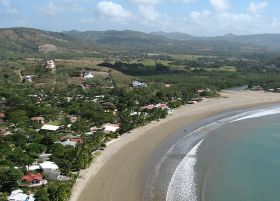 In San Juan del Sur, you get to meet a lot of people who I really enjoy, personally. There’s a nice mix of cultures and you can see a lot of expats who have blended very well with the locals. It’s an interesting place. There are several small restaurants, bars, cafes and nice hotels out there.
In San Juan del Sur, you get to meet a lot of people who I really enjoy, personally. There’s a nice mix of cultures and you can see a lot of expats who have blended very well with the locals. It’s an interesting place. There are several small restaurants, bars, cafes and nice hotels out there. San Juan del Sur is about an hour and half by car from Managua. There are many beautiful beaches that are not crowded and just 15 minutes from this coastal town. Both these beaches and San Juan del Sur itself have plenty of water sports that many people love.
Leon
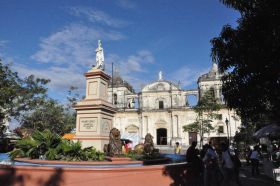 Leon, along with Granada, is one of the oldest colonial cities here in Nicaragua. Actually, Leon has a larger population than Granada and it is where one of the wealthiest families in Nicaragua lives. I guess it’s about an hour and a half from Managua.
Leon, along with Granada, is one of the oldest colonial cities here in Nicaragua. Actually, Leon has a larger population than Granada and it is where one of the wealthiest families in Nicaragua lives. I guess it’s about an hour and a half from Managua. Leon is at sea level and just 20 minutes away from the beaches, which are all very nice. Personally, I haven’t gone to those beaches but people say that you can go surfing there. There are also a lot of young people in Leon because it has a national university. The city also has a beautiful museum that’s opened up recently.
Central Pacific Beach Area
The Central Pacific beach areas, including Gran Pacifica and Rancho Santa Rosa, are technically in the department of Managua, but are located about an hour away from the city, on the Pacific Ocean. The Central Pacific Beach areas are generally larger, planned communities, with many expat residents.
Posted September 10, 2014
Gabriel Sánchez - PRONicaragua
We can divide Nicaragua into those areas on the Pacific side (which is where the majority of the population lives and where the country is more developed) and on the Atlantic side.
On the Pacific side, the main city of Nicaragua is Managua. In addition, there are the more manufacturing and commerce cities like Chinandega. There’s the mountainous areas, where the temperature is cooler and where the coffee is grown. There are also places...
We can divide Nicaragua into those areas on the Pacific side (which is where the majority of the population lives and where the country is more developed) and on the Atlantic side.
On the Pacific side, the main city of Nicaragua is Managua. In addition, there are the more manufacturing and commerce cities like Chinandega. There’s the mountainous areas, where the temperature is cooler and where the coffee is grown. There are also places that are known primarily for tourism, such as Granada, Leon, and further in the south of the country, there’s San Juan del Sur and Rivas, which has beach communities and towns that are hot attractions.
On the Caribbean or Atlantic side of Nicaragua, there is a totally different environment than in the Pacific side, with two major cities: Puerto Cabezas in the north and Bluefields in the south.
* Managua – This is the main city and the capital of Nicaragua. It’s the largest city and the country’s business center, located on Lake Managua, less than an hour from the Pacific Ocean.
* Granada - Granada is just southeast of Managua, on the northern coast of Lake Nicaragua, about an hour from the Pacific Ocean. Granada is one of the oldest cities in Continental America, over 500 years old. It’s a tourism attraction and one of the main tourism spots in Nicaragua.
* Managua – This is the main city and the capital of Nicaragua. It’s the largest city and the country’s business center, located on Lake Managua, less than an hour from the Pacific Ocean.
* Granada - Granada is just southeast of Managua, on the northern coast of Lake Nicaragua, about an hour from the Pacific Ocean. Granada is one of the oldest cities in Continental America, over 500 years old. It’s a tourism attraction and one of the main tourism spots in Nicaragua.
Granada is a colonial city that has maintained its colonial style through the years, so it draws a lot of attention from tourists all over the world. Its location on the northern coast of Lake Nicaragua makes it a very hot spot for tourists. You can go to the lake and you can go fishing. It has over 360 little islands just right off the coast of the lake. It’s a very attractive place to go. Granada has a colonial feel and a great view of the lake and the islands right off the coast.
* Leon – Leon is very similar to Granada in the sense that it’s also one of the older cities. It is 500 years old and is a very hot tourism spot in Nicaragua as well. Leon also has maintained its colonial style. You can see it in many of its buildings, including the cathedral which is the most iconic building in the city. Leon is a city with a lot of history. It’s also the birthplace of one of the greatest poets in Nicaragua, Rubén Dario. There’s a museum about him which also draws a lot of attention.
* Chinandega – Chinandega is the town located up on the northwest part of the country and is an economic powerhouse. One of the attractions there is the largest port in the Pacific Coast called Port Corinto, which has boosted the economic development of the region because the port provides easy access to the port and destinations on the Pacific Coast of the continent. For example, if they are going to export to California, that’s the place to go. You have a lot of production in manufacturing and in agriculture in this region.
* Leon – Leon is very similar to Granada in the sense that it’s also one of the older cities. It is 500 years old and is a very hot tourism spot in Nicaragua as well. Leon also has maintained its colonial style. You can see it in many of its buildings, including the cathedral which is the most iconic building in the city. Leon is a city with a lot of history. It’s also the birthplace of one of the greatest poets in Nicaragua, Rubén Dario. There’s a museum about him which also draws a lot of attention.
* Chinandega – Chinandega is the town located up on the northwest part of the country and is an economic powerhouse. One of the attractions there is the largest port in the Pacific Coast called Port Corinto, which has boosted the economic development of the region because the port provides easy access to the port and destinations on the Pacific Coast of the continent. For example, if they are going to export to California, that’s the place to go. You have a lot of production in manufacturing and in agriculture in this region.
* San Juan del Sur – San Juan del Sur is located on the southwest Pacific coast of Nicaragua in an area that is the main beach attraction for tourists in the country. It is a small town that has a spectacular bay. There are lots of expats living in San Juan del Sur, not just from the US, but from other countries as well. You can go there almost every night of the year and find foreigners from countries all around the world who are visiting. It has beaches and neighboring bays where you can surf, which is a big attraction. We even have international surfing tournaments in some of the nearby beaches. San Juan del Sur a very authentic town, which is one of the primary things that draws people to go there. It still has its own local restaurants and local hotels and maintains its beach town essence.
* Jinotega and Matagalpa – Jinotega and Matagalpa are both located in the north central area of Nicaragua in a mountainous area. The altitude makes the weather substantially different and a lot cooler than it is on the Pacific coast. This is the area where most of the Nicaraguan coffee is grown. These are quite underdeveloped, yet authentic as well. Jinotega and Matagalpa are classic colonial towns. They have a cathedral and a central park and the city. It’s a very nice place in the mountains. It’s very green and you can see flowers growing on the roadside. It’s very colorful up there in the north. They have their own folklore and cultural traditions.
* Puerto Cabezas and Bluefields –The Caribbean coast is divided into two regions, the north region and the south region. Puerto Cabezas is the capital of the north region and Bluefields is in the south region.
The whole Caribbean side has lots of potential to develop and grow. It hasn’t seen the progress that the Pacific side already has, which is something that Nicaraguans are working on. Hopefully, there would be much more progress in that area. For now, traditional fishing is the main economic activity of the region.
In the south, you have Bluefields. In existing to fishing activities, there’s some tourism that’s happening there, which is growing because of the Miskito islands, which are just off the coast and are very Caribbean-like. The Nicaraguan Caribbean Coast is not white sand and crystal clear water. However, just off the coast, the cayes and the other islands such as Corn Island, are very Caribbean because of the white sands and crystal clear water. That is a very big attraction for Nicaraguans and foreigners who want the feel of what the Caribbean coast of Nicaragua is like.
A unique characteristic of the Caribbean coast of Nicaragua is that it has different cultural descendants than the Pacific side. Descendants of African origin generally populate the Caribbean coast and there is a mixture with English descent as well, in addition to the local natives, who also mixed in from several hundred years ago. People in the Caribbean are usually darker in skin, have a different religion, and they speak a language called Creole, which is a mixture of English and local languages.
Posted February 8, 2015
Gabriel Sánchez - PRONicaragua
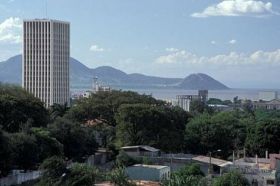 We can divide Nicaragua into those areas on the Pacific side (which is where the majority of the population lives and where the country is more developed) and on the Atlantic side.
We can divide Nicaragua into those areas on the Pacific side (which is where the majority of the population lives and where the country is more developed) and on the Atlantic side. On the Pacific side, the main city of Nicaragua is Managua. In addition, there are the more manufacturing and commerce cities like Chinandega. There’s the mountainous areas, where the temperature is cooler and where the coffee is grown. There are also places...
 We can divide Nicaragua into those areas on the Pacific side (which is where the majority of the population lives and where the country is more developed) and on the Atlantic side.
We can divide Nicaragua into those areas on the Pacific side (which is where the majority of the population lives and where the country is more developed) and on the Atlantic side. On the Pacific side, the main city of Nicaragua is Managua. In addition, there are the more manufacturing and commerce cities like Chinandega. There’s the mountainous areas, where the temperature is cooler and where the coffee is grown. There are also places that are known primarily for tourism, such as Granada and Leon, and further in the south of the country, there’s San Juan del Sur and Rivas, which has beach communities and towns that are hot attractions.
On the Caribbean or Atlantic side of Nicaragua, there is a totally different environment than in the Pacific side, with two major cities: Puerto Cabezas in the north and Bluefields in the south.
Managua – This is the main city and the capital of Nicaragua. It’s the largest city and the country’s business center, located on Lake Managua, less than an hour from the Pacific Ocean.
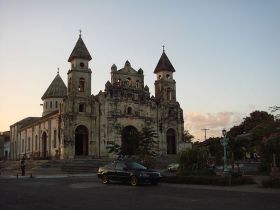 Granada - Granada is just southeast of Managua, on the northern coast of Lake Nicaragua, about an hour from the Pacific Ocean. Granada is one of the oldest cities in continental America, over 500 years old. It’s a tourism attraction and one of the main tourism spots in Nicaragua.
Granada - Granada is just southeast of Managua, on the northern coast of Lake Nicaragua, about an hour from the Pacific Ocean. Granada is one of the oldest cities in continental America, over 500 years old. It’s a tourism attraction and one of the main tourism spots in Nicaragua.
Managua – This is the main city and the capital of Nicaragua. It’s the largest city and the country’s business center, located on Lake Managua, less than an hour from the Pacific Ocean.
 Granada - Granada is just southeast of Managua, on the northern coast of Lake Nicaragua, about an hour from the Pacific Ocean. Granada is one of the oldest cities in continental America, over 500 years old. It’s a tourism attraction and one of the main tourism spots in Nicaragua.
Granada - Granada is just southeast of Managua, on the northern coast of Lake Nicaragua, about an hour from the Pacific Ocean. Granada is one of the oldest cities in continental America, over 500 years old. It’s a tourism attraction and one of the main tourism spots in Nicaragua. Granada is a colonial city that has maintained its colonial style through the years, so it draws a lot of attention from tourists from all over the world. Its location on the northern coast of Lake Nicaragua makes it a very hot spot for tourists. You can go to the lake and you can go fishing. It has over 360 little islands just right off the coast of the lake. It’s a very attractive place to go. Granada has a colonial feel and a great view of the lake and the islands right off the coast.
 Leon – Leon is very similar to Granada in the sense that it’s also one of the older cities. It is 500 years old and is a very hot tourism spot in Nicaragua as well. Leon also has maintained its colonial style. You can see it in many of its buildings, including the cathedral which is the most iconic building in the city. Leon is a city with a lot of history. It’s also the birthplace of one of the greatest poets in Nicaragua, Rubén Dario. There’s a museum about him which also draws a lot of attention.
Leon – Leon is very similar to Granada in the sense that it’s also one of the older cities. It is 500 years old and is a very hot tourism spot in Nicaragua as well. Leon also has maintained its colonial style. You can see it in many of its buildings, including the cathedral which is the most iconic building in the city. Leon is a city with a lot of history. It’s also the birthplace of one of the greatest poets in Nicaragua, Rubén Dario. There’s a museum about him which also draws a lot of attention.
Chinandega – Chinandega is the town located up on the northwest part of the country and is an economic powerhouse. One of the attractions there is the largest port in the Pacific Coast called Port Corinto, which has boosted the economic development of the region because the port provides easy access to the port and to destinations on the Pacific Coast of the continent. For example, if you are going to export to California, that’s the place to go. You have a lot of production in manufacturing and in agriculture in this region.
 Leon – Leon is very similar to Granada in the sense that it’s also one of the older cities. It is 500 years old and is a very hot tourism spot in Nicaragua as well. Leon also has maintained its colonial style. You can see it in many of its buildings, including the cathedral which is the most iconic building in the city. Leon is a city with a lot of history. It’s also the birthplace of one of the greatest poets in Nicaragua, Rubén Dario. There’s a museum about him which also draws a lot of attention.
Leon – Leon is very similar to Granada in the sense that it’s also one of the older cities. It is 500 years old and is a very hot tourism spot in Nicaragua as well. Leon also has maintained its colonial style. You can see it in many of its buildings, including the cathedral which is the most iconic building in the city. Leon is a city with a lot of history. It’s also the birthplace of one of the greatest poets in Nicaragua, Rubén Dario. There’s a museum about him which also draws a lot of attention.Chinandega – Chinandega is the town located up on the northwest part of the country and is an economic powerhouse. One of the attractions there is the largest port in the Pacific Coast called Port Corinto, which has boosted the economic development of the region because the port provides easy access to the port and to destinations on the Pacific Coast of the continent. For example, if you are going to export to California, that’s the place to go. You have a lot of production in manufacturing and in agriculture in this region.
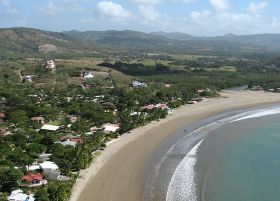 San Juan del Sur – San Juan del Sur is located on the southwest Pacific coast of Nicaragua in an area that is the main beach attraction for tourists in the country. It is a small town that has a spectacular bay. There are lots of expats living in San Juan del Sur, not just from the US, but from other countries as well. You can go there almost every day of the year and find foreigners from countries all around the world who are visiting. It has beaches and neighboring bays where you can surf, which is a big attraction. We even have international surfing tournaments in some of the nearby beaches. San Juan del Sur is a very authentic town, which is one of the primary things that draws people to go there. It still has its own local restaurants and local hotels and maintains its beach town essence.
San Juan del Sur – San Juan del Sur is located on the southwest Pacific coast of Nicaragua in an area that is the main beach attraction for tourists in the country. It is a small town that has a spectacular bay. There are lots of expats living in San Juan del Sur, not just from the US, but from other countries as well. You can go there almost every day of the year and find foreigners from countries all around the world who are visiting. It has beaches and neighboring bays where you can surf, which is a big attraction. We even have international surfing tournaments in some of the nearby beaches. San Juan del Sur is a very authentic town, which is one of the primary things that draws people to go there. It still has its own local restaurants and local hotels and maintains its beach town essence.Jinotega and Matagalpa – Jinotega and Matagalpa are both located in the north central area of Nicaragua in a mountainous area. The altitude makes the weather substantially different and a lot cooler than it is on the Pacific coast. This is the area where most of the Nicaraguan coffee is grown. These are quite underdeveloped, yet authentic as well. Jinotega and Matagalpa are classic colonial towns. They have a cathedral and a central park and the city. It’s a very nice place in the mountains. It’s very green and you can see flowers growing on the roadside. It’s very colorful up there in the north. They have their own folklore and cultural traditions.
Puerto Cabezas and Bluefields –The Caribbean coast is divided into two regions, the north region and the south region. Puerto Cabezas is the capital of the north region and Bluefields is in the south region.
The whole Caribbean side has lots of potential to develop and grow. It hasn’t seen the progress that the Pacific side already has, which is something that Nicaraguans are working on. Hopefully, there would be much more progress in that area. For now, traditional fishing is the main economic activity of the region.
In the south, you have Bluefields. In existing to fishing activities, there’s some tourism that’s happening there, which is growing because of the Pearl Cayes (islands), which are just off the coast and are very Caribbean-like. The Nicaraguan Caribbean Coast is not white sand and crystal clear water. However, just off the coast, the cayes and the other islands such as Corn Island, are very Caribbean because of the white sands and crystal clear water. That is a very big attraction for Nicaraguans and foreigners who want the feel of what the Caribbean coast of Nicaragua is like.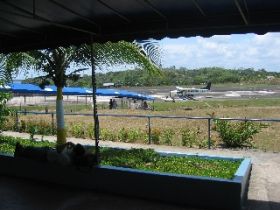 (Airport in Bluefields, pictured at right/)
(Airport in Bluefields, pictured at right/)
 (Airport in Bluefields, pictured at right/)
(Airport in Bluefields, pictured at right/) A unique characteristic of the Caribbean coast of Nicaragua is that it has different cultural descendants than the Pacific side. Descendants of African origin generally populate the Caribbean coast and there is a mixture with English descent as well, in addition to the local natives, who also mixed in from several hundred years ago. People in the Caribbean are usually darker in skin, have a different religion, and they speak a language called Creole, which is a mixture of English and local languages.
Posted February 8, 2015


